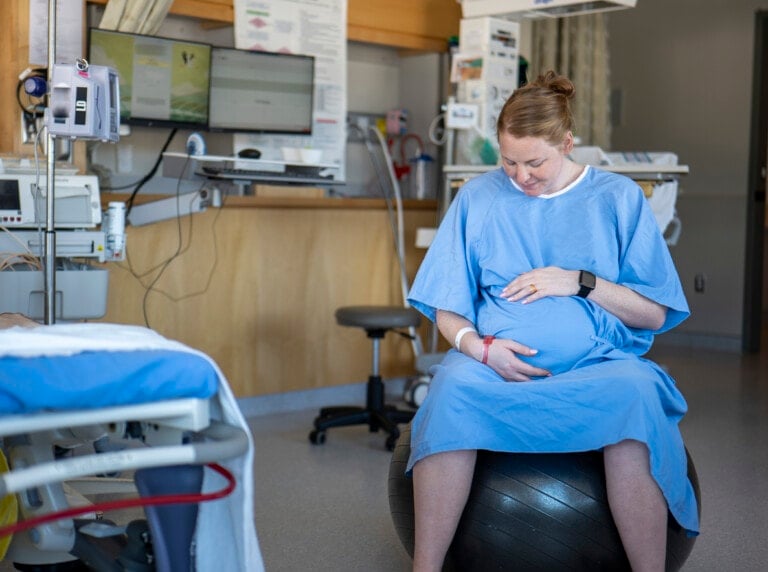As you prepare for birth, you might wonder how you will cope with the pain of labor and delivery. There are many ways to manage contractions, crowning (the ring of fire), and pushing. One popular method is the use of breathing techniques for labor.1
Many labor breathing techniques can be used at different points in your childbirth experience. It is best to learn these breathing techniques for labor ahead of time. That way, you can practice them during other painful or uncomfortable experiences during pregnancy. Practicing these pregnancy breathing exercises may help them to become automatic or second nature when the time comes to use them.
How Do Breathing Techniques for Labor Help Manage Pain?
Breathing plays a role in pain sensations’ physical and mental aspects during contractions. Mentally, learning to breathe during contractions distracts you from the pain and gives you something to concentrate on rather than how much it hurts. Getting through contractions one breath at a time feels easier than thinking, “When is this going to end?” for the duration of each contraction. Breathing techniques can aid in mental and physical relaxation during labor.2
Physically, different labor breathing techniques can ensure adequate oxygen delivery to vital organs during labor. This can provide energy to get through labor when you feel fatigued and depleted. Attentive breathing also engages the core and pelvic floor muscles, encouraging activation and oxygenation.2,3
Not only do breathing techniques for labor help you manage and decrease pain, but they may also help your labor progress and shorten the pushing phase.3
You may find you can relax the rest of your body better while focusing on your breathing. This may prevent you from clenching or guarding against contractions, instead allowing them to do their job—dilate your cervix and move your baby down.
Effective Breathing Techniques for Labor
If you are wondering how to breathe through contractions, you can try different breathing techniques for labor. Before employing any of these methods, take a deep cleansing breath to start and exhale. On that initial exhale, let your body completely relax or go limp before starting the chosen breathing technique for the contraction.
Belly Breathing
Belly breathing is usually the best breathing technique for early labor when you are experiencing contractions, but the pain is not yet severe. To practice belly breathing, focus on how your belly moves when breathing in and out.
First, place a hand on your belly. Inhale through your nose and notice that your belly moves your hand outward on your inhale. Push your belly out as far as possible while breathing in, and try not to move your chest.4,5
Let your belly fall as low as possible on your exhale as it moves in. Relax your belly and chest completely. Blow out through tight lips so your air is meeting resistance. Imagine your hand is pushing all the air out of your belly.4,5
Slow, Paced Breathing
As labor progresses and contractions intensify, you may need to change up your pregnancy breathing exercise. Slow and paced or patterned breathing can be used when belly breathing is no longer helping you get through a contraction.
Slow and paced breathing is essentially just taking long, deep breaths. Slowly inhale through your nose, then exhale through your mouth. Try to focus on relaxing a different part of your body during each inhale. It may help to sigh, moan, or vocalize during your exhales. Pause momentarily after you finish breathing out, allowing your body to crave the next breath.6
Light, Accelerated Breathing
As you enter the active stage of labor, new breathing techniques for labor may be useful when contractions become stronger and more painful.
Light, accelerated breathing is similar to hyperventilating. Breathe in and out rapidly through the mouth at about one breath per second. Increase the speed of your inhales and exhales as the contraction peaks. The intensity of your breathing should match the intensity of the contraction. As the contraction wanes, gradually slow your breaths. Of course, if you experience lightheadedness, try to return to your normal breath.6,7
Variable Breathing for Labor
Variable breathing combines light, accelerated breathing with slow breathing. This labor breathing technique is often seen in the movies when a laboring mother makes a “hee-hee-who” sound during contractions.
To practice variable breathing, take a few shallow, rapid breaths followed by one long, vocal exhale. The long exhale can also be more of a blowing breath. You can change up the number of fast breaths you take before a slow one—do whatever feels most helpful and comfortable for you.6,7
Expulsion Breathing
As the name suggests, expulsion breathing should be used during pushing to help you expel the baby from your birth canal.
As a contraction begins, take some breaths to prepare yourself to push. Take light, shallow breaths to hold back pushing with the beginning of a contraction — let it gain momentum. When you cannot resist pushing any longer, breathe or blow out low and slow. Moan or grunt for a count of six while visualizing your baby moving down and out of your body. While pushing, focus on surrendering or relaxing your pelvic floor. After each push, release your breath and catch it before surrendering to the urge to push. You may feel multiple urges to push during one contraction.6
Having tools in your back pocket is good when labor gets intense or even unbearable. Breathing techniques for labor are just one of these tools for pushing through contractions and coming out on the other side, and cuddling your new baby. Learning these breathing techniques is essential, but it is equally important to practice them in advance. Make sure your partner knows these techniques, too. They can refer back and coach you to use pregnancy breathing exercises in the pain and stress of the moment when you may not remember.































